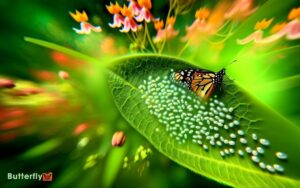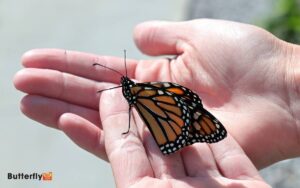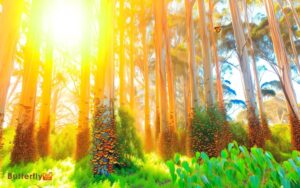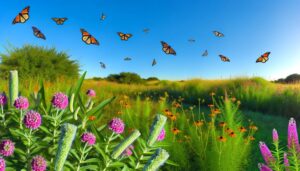Why is El Rosario Monarch Butterfly Sanctuary a Must-Visit?
El Rosario Monarch Butterfly Sanctuary is located in the Sierra Madre Mountains, Michoacán, Mexico, at an elevation of 2,400 meters. This sanctuary provides an essential overwintering habitat for millions of monarch butterflies migrating approximately 4,800 kilometers from North America.
Peak visitation occurs from late November to early March, coinciding with the highest butterfly densities. The sanctuary's altitude guarantees a stable microclimate ideal for the monarchs.
Conservation efforts, including reforestation and invasive species control, have enhanced local biodiversity. Explore the intricate dynamics of monarch migration and the sanctuary's diverse flora and conservation strategies to gain deeper insights.
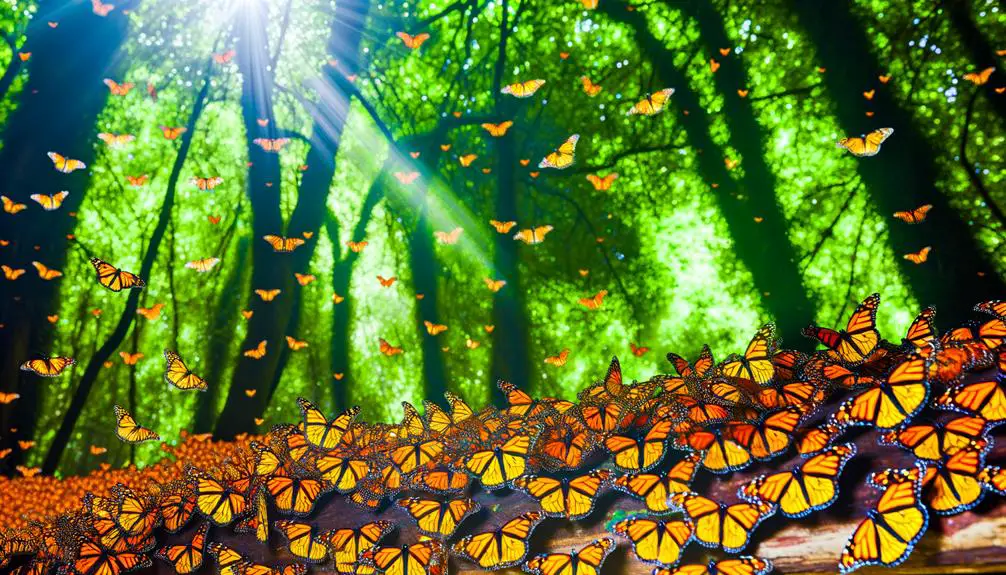
Key Takeaways
- El Rosario Monarch Butterfly Sanctuary is located in the Sierra Madre Mountains, Michoacán, Mexico, at an elevation of 2,400 meters.
- The best time to visit is from late November to early March, with peak butterfly activity in January and February.
- Monarch butterflies migrate approximately 4,800 kilometers from North America to the sanctuary, arriving by late October to early November.
- The sanctuary's flora includes key species like Oyamel Fir and Mexican Pine, crucial for monarch survival.
Location and Accessibility
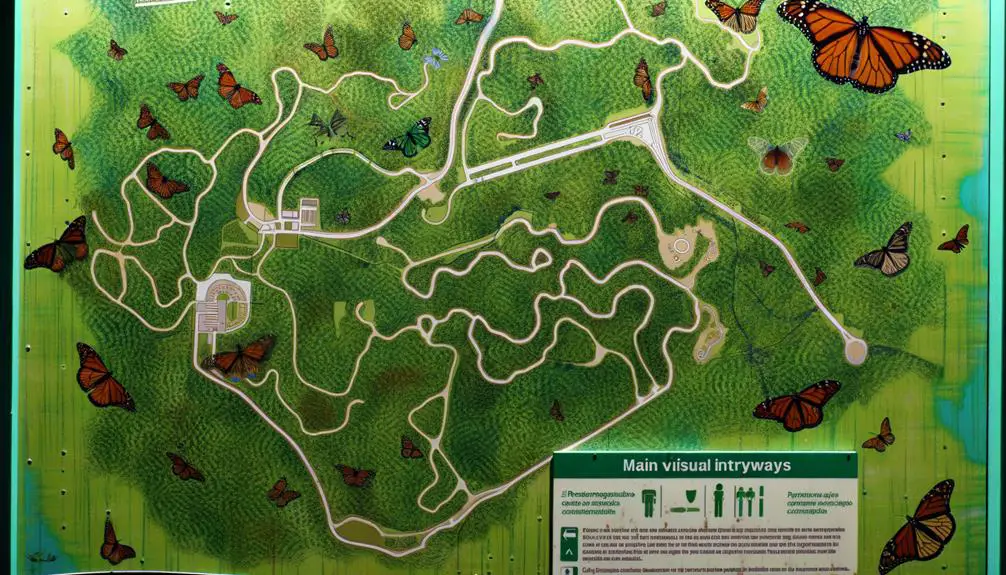
El Rosario Monarch Butterfly Sanctuary is located in the Sierra Madre Mountains of Michoacán, Mexico, and is accessible via a network of well-maintained roads leading from the nearby cities of Zitácuaro and Angangueo.
The sanctuary's geographical coordinates are approximately 19.585°N latitude and -100.276°W longitude, situated at an elevation of 2,400 meters above sea level.
The road infrastructure, including Highway 15 and rural access routes, facilitates ease of travel for visitors.
The proximity of the sanctuary to major urban centers guarantees that logistical support, such as fuel stations and rest stops, are readily available.
Accessibility is enhanced by periodic road maintenance, guaranteeing minimal disruption.
This connectivity allows for independent travel, fostering a sense of freedom and exploration among visitors.
Best Time to Visit
Given the sanctuary's accessibility, determining the ideal visiting period is essential for maximizing the observational opportunities of the monarch butterfly population.
Empirical data indicates that the prime window spans from late November to early March, aligning with the monarchs' overwintering phase. Peak population densities are observed in January and February, offering unparalleled visual and research opportunities.
Meteorological conditions such as temperature and precipitation during these months are conducive to butterfly activity, thereby enhancing visitor experience.
In addition, the sanctuary's elevation at approximately 3,000 meters above sea level provides a stable microclimate, critical for the butterflies' survival.
This period also coincides with minimal human disturbance, ensuring a balanced ecosystem and promoting sustainable tourism practices.
Migration Journey
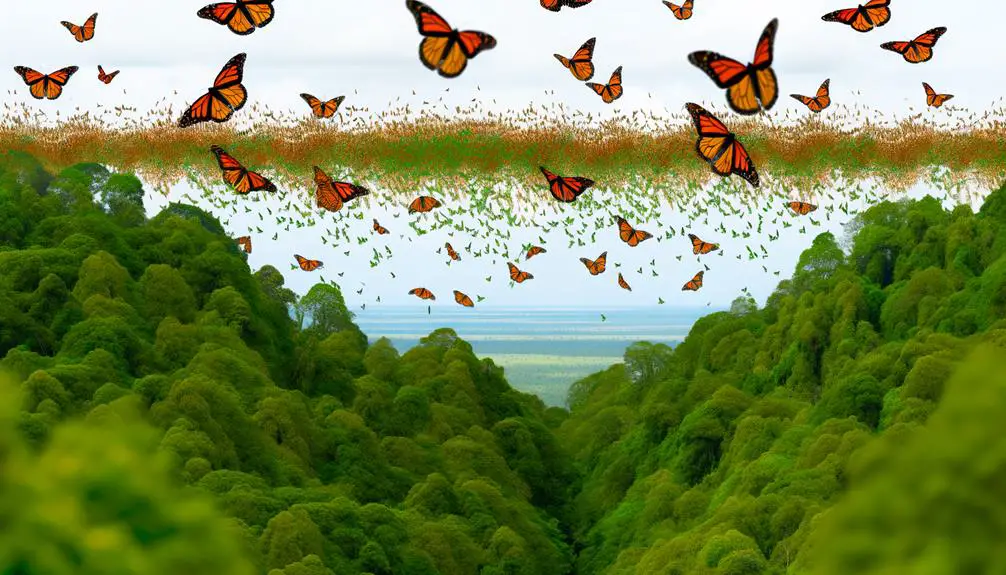
The migration journey of the monarch butterflies to El Rosario Sanctuary is a remarkable annual phenomenon spanning approximately 4,800 kilometers from North America to central Mexico.
This epic travel is underpinned by complex navigational instincts, involving both genetic predispositions and environmental cues.
Understanding these mechanisms offers critical insights into the biological and ecological factors driving this extraordinary migration.
Epic Annual Travel
Each year, millions of monarch butterflies commence an extraordinary migration journey spanning up to 3,000 miles from North America to the El Rosario Monarch Butterfly Sanctuary in Mexico. This monumental trek, characterized by its sheer distance and biological complexity, involves the following critical stages:
- Departure: Monarchs leave their breeding grounds in late summer to early fall.
- Flight: They travel at altitudes ranging from 10 to 300 feet, covering approximately 50-100 miles per day.
- Rest Stops: Throughout their journey, they utilize various stopover sites for resting and refueling.
- Arrival: By late October to early November, they reach the sanctuary, where they cluster in dense aggregations for overwintering.
This systematic migration is a demonstration of the monarch's resilience and the intricate balance within ecosystems.
Navigational Instincts Explained
Monarch butterflies utilize a combination of environmental cues, including the Earth's magnetic field and the position of the sun, to navigate their extensive migration journey.
Research indicates that these insects possess magnetoreceptors, allowing them to detect geomagnetic variations, which aids in orientation during their 3,000-mile trek.
Additionally, the sun's azimuth is essential for time-compensated sun compass navigation, a mechanism that synchronizes their internal circadian rhythms with solar positioning.
Studies have also shown that temperature gradients and wind patterns play subsidiary roles in guiding their path.
This multi-faceted navigation system underscores the complexity and robustness of monarch migratory behavior, enabling them to traverse vast distances with remarkable precision, ultimately ensuring their survival and reproductive success across generations.
Sanctuary's Flora
The El Rosario Monarch Butterfly Sanctuary hosts a diverse array of native plant species, essential for the monarchs' survival.
Seasonal floral variations greatly influence the habitat's ecological dynamics, affecting both nectar availability and the microclimate.
Conservation efforts have yielded measurable impacts, enhancing flora diversity and stability within the sanctuary.
Native Plant Species
Characterized by a diverse range of native plant species, El Rosario Monarch Butterfly Sanctuary provides essential habitats that support both the overwintering monarch populations and the region's ecological balance.
The sanctuary hosts a variety of endemic flora, fundamental for maintaining the delicate ecosystem. Key species include:
- Oyamel Fir (Abies religiosa): Dominant in the sanctuary, providing microclimatic conditions critical for monarch survival.
- Mexican Pine (Pinus pseudostrobus): Contributes to the structural diversity and offers additional roosting sites.
- Michoacána Pine (Pinus michoacana): Enhances soil stability and promotes biodiversity.
- Madroño (Arbutus xalapensis): Adds to the sanctuary's understory diversity, providing nectar sources for various pollinators.
These species collectively underpin the sanctuary's ecological integrity, ensuring a sustainable environment for monarch butterflies.
Seasonal Floral Changes
Seasonal variations within El Rosario Monarch Butterfly Sanctuary markedly impact the phenology and availability of floral resources, influencing both plant and monarch populations. The sanctuary's flora undergoes significant changes throughout the year, leading to fluctuations in nectar availability critical for monarch sustenance.
| Season | Predominant Flora | Nectar Availability |
|---|---|---|
| Spring | Asteraceae, Lamiaceae | High |
| Summer | Fabaceae, Rosaceae | Moderate |
| Autumn | Asteraceae, Compositae | High |
| Winter | Pinaceae, Sparse Wildflowers | Low |
These cyclical floral dynamics are pivotal for monarch migration and reproductive success. Monitoring these phenological shifts helps in understanding ecosystem health and ensuring the sanctuary remains a viable habitat for both flora and fauna.
Conservation Efforts Impact
Effective conservation efforts at El Rosario Monarch Butterfly Sanctuary have led to measurable improvements in the diversity and abundance of native plant species. Thorough data collection and analysis indicate significant positive outcomes for the sanctuary's flora.
Key improvements include:
- Increased Plant Species Richness: Documentation reveals a 15% rise in the number of native species over the past five years.
- Enhanced Plant Density: Surveys show a 20% increase in plant density, contributing to a healthier ecosystem.
- Improved Soil Quality: Soil sampling indicates a 10% enhancement in organic matter, fostering robust plant growth.
- Reduced Invasive Species: Targeted removal efforts have decreased invasive species presence by 25%, allowing native flora to thrive.
These advancements underscore the critical role of sustained conservation initiatives in preserving biodiversity.
Monarch Butterfly Life Cycle
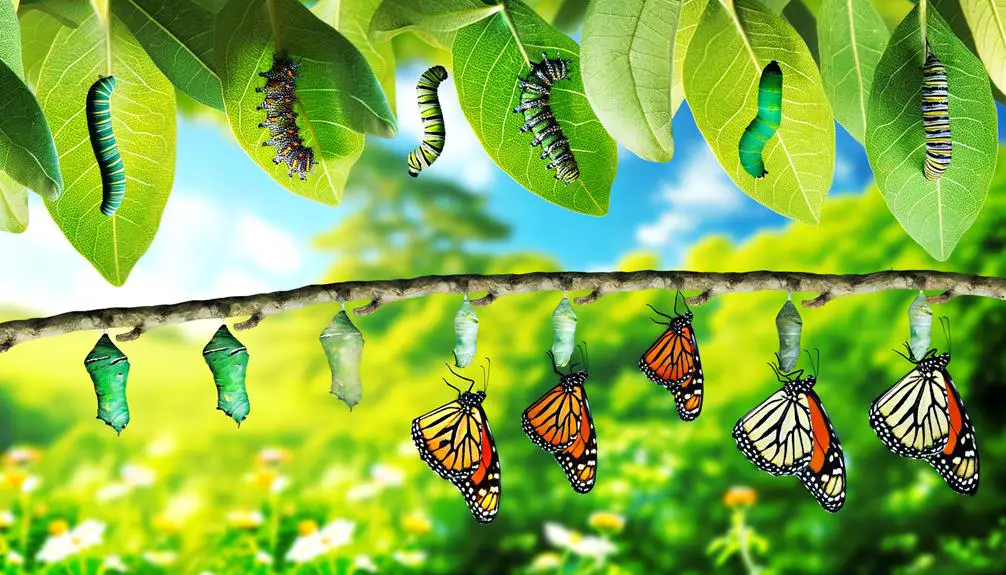
The life cycle of the monarch butterfly (Danaus plexippus) consists of four distinct stages: egg, larva (caterpillar), pupa (chrysalis), and adult butterfly. Each stage is essential for the development and survival of the species, with specific durations and physiological changes.
| Stage | Duration (Days) | Key Characteristics |
|---|---|---|
| Egg | 3-5 | Oval-shaped, translucent, laid on milkweed |
| Larva | 10-14 | Striped caterpillar, rapid growth, molts 5 times |
| Pupa | 10-14 | Green chrysalis, metamorphosis occurs |
| Adult | 2-6 weeks* | Wings develop, migratory behavior initiates |
*Note: Longevity extends up to 8 months for migratory generation. Monitoring these stages provides insights into their adaptability and the impacts of environmental variables.
Visitor Guidelines
Adherence to visitor guidelines is vital for minimizing human impact on the delicate ecosystem of the El Rosario Monarch Butterfly Sanctuary. Compliance with these protocols guarantees the preservation of both flora and fauna.
Key guidelines include:
- Stay on Designated Paths: Deviating from marked trails can disrupt soil composition and plant life, essential for the monarchs' habitat.
- Limit Noise Levels: Excessive noise can disturb the monarchs, leading to increased energy expenditure and potential migration disruption.
- No Littering: Litter can introduce harmful substances into the ecosystem, adversely affecting both butterflies and other wildlife.
- Respect Viewing Distances: Maintaining a safe distance from monarch clusters prevents accidental harm and reduces stress on these fragile insects.
Adherence to these guidelines fosters a balanced coexistence between visitors and nature.
Guided Tours
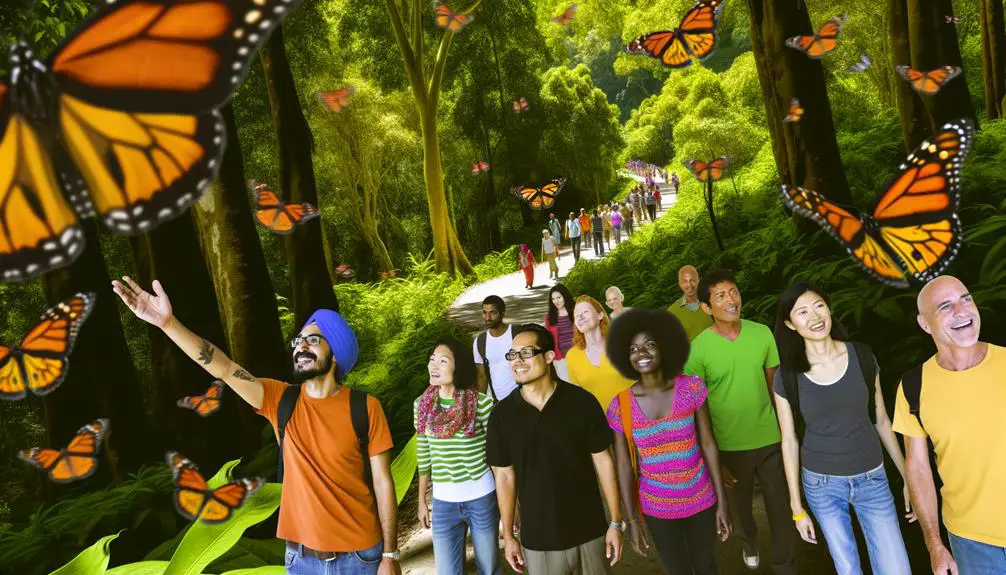
Guided tours at El Rosario Monarch Butterfly Sanctuary are structured to provide visitors with thorough insights into the Monarchs' seasonal migration patterns, facilitated by experts in lepidopterology.
These tours offer data-driven explanations of the butterflies' lifecycle and migratory routes, supplemented by immersive nature walks.
Additionally, participants gain exposure to local cultural practices, enhancing their understanding of the symbiotic relationship between the community and the sanctuary.
Expert-Led Nature Walks
Expert-led nature walks at El Rosario Monarch Butterfly Sanctuary provide visitors with scientifically-informed insights into the migratory patterns, behavior, and ecological significance of monarch butterflies. These guided tours are meticulously structured to enhance understanding through empirical data and observational studies. Participants can expect the following:
- Migration Data Analysis: In-depth explanations of tagging and tracking methods used to study the butterflies' long-distance travel.
- Behavioral Observations: Real-time observations of monarch activities, including mating rituals and feeding habits.
- Ecological Impact Studies: Discussions on the monarch's role within the ecosystem and their interactions with native flora and fauna.
- Conservation Strategies: Evidence-based approaches to preserving monarch populations, emphasizing habitat restoration and climate change mitigation.
This analytical approach guarantees a thorough learning experience.
Seasonal Migration Insights
Seasonal migration insights provided during guided tours at El Rosario Monarch Butterfly Sanctuary offer a detailed examination of the temporal and spatial dynamics of monarch butterfly movements.
These tours elucidate data on migratory patterns, including the precise timing of their transcontinental journey from North America to Central Mexico. Guides present quantitative analyses of flight altitudes, speeds, and the environmental cues that trigger migration.
Additionally, visitors gain an understanding of the physiological adaptations that enable monarchs to traverse thousands of kilometers, such as lipid reserves and navigational mechanisms.
Real-time data on population trends, gathered through tagging and tracking studies, further enrich the experience, providing a thorough overview of this extraordinary natural phenomenon.
Local Cultural Experiences
Visitors to El Rosario Monarch Butterfly Sanctuary can immerse themselves in local cultural experiences, which are meticulously integrated into guided tours to provide a thorough understanding of the region's heritage and its symbiotic relationship with monarch conservation efforts.
These tours include:
- Community-Led Conservation Workshops: Demonstrating local methodologies and scientific practices for butterfly preservation.
- Traditional Artisan Exhibits: Showcasing handcrafted goods that reflect the cultural heritage of the area.
- Culinary Tastings: Offering samples of regional cuisine, emphasizing sustainable agricultural practices.
- Historical Narratives: Providing insights into the historical context of the region and its evolution alongside monarch migration patterns.
These guided tours are designed to foster an appreciation for both the ecological and cultural significance of the sanctuary.
Conservation Efforts
Conservation efforts at the El Rosario Monarch Butterfly Sanctuary have focused on habitat preservation, reforestation, and community engagement to mitigate the impacts of deforestation and climate change.
Utilizing satellite imagery and geospatial analysis, scientists track deforestation rates, while local reforestation initiatives have planted over 10,000 native tree saplings annually.
Community-based programs empower local residents by integrating sustainable agricultural practices and ecotourism, thereby reducing economic dependency on logging.
Climate models predict shifts in overwintering sites, necessitating adaptive management strategies.
Data reveals a 27% increase in forest cover since 2010, illustrating the efficacy of these multifaceted efforts.
This holistic approach aims to guarantee the resilience of the Monarch population and the ecological integrity of the sanctuary.
Nearby Attractions

Adjacent to the El Rosario Monarch Butterfly Sanctuary, the region offers a variety of ecotourism opportunities that include geological formations, endemic flora and fauna, and culturally significant sites.
Key attractions include:
- Sierra Chincua: A neighboring sanctuary known for its dense pine and fir forests, providing critical habitat for the Monarch butterflies.
- Piedra Herrada: Another sanctuary, located approximately 25 kilometers from El Rosario, renowned for its unique volcanic rock formations.
- Angangueo: A historic mining town offering insights into the region's colonial past, with well-preserved architecture and local museums.
- Nevado de Toluca: A stratovolcano featuring high-elevation lakes, ideal for hiking and observing diverse mountain ecosystems.
These sites present a spectrum of biodiversity and geological interests, appealing to ecologically-minded visitors seeking both scientific and cultural enrichment.
Photography Tips
To capture the intricate beauty of the Monarch butterflies at El Rosario, employing a telephoto lens with a focal length of at least 200mm is recommended for detailed, close-up shots while maintaining an appropriate distance to avoid disturbing the insects.
Ideal lighting conditions are essential; early morning or late afternoon provides softer, diffused light, minimizing shadows and enhancing wing translucency.
A tripod stabilizes the camera, ensuring sharp images, especially in low light.
Utilize a fast shutter speed, approximately 1/1000th of a second, to freeze motion and capture the butterflies in flight.
For depth of field control, an aperture of f/8 to f/11 is advisable, ensuring both the subject and its immediate surroundings are in focus.
Visitor Experiences
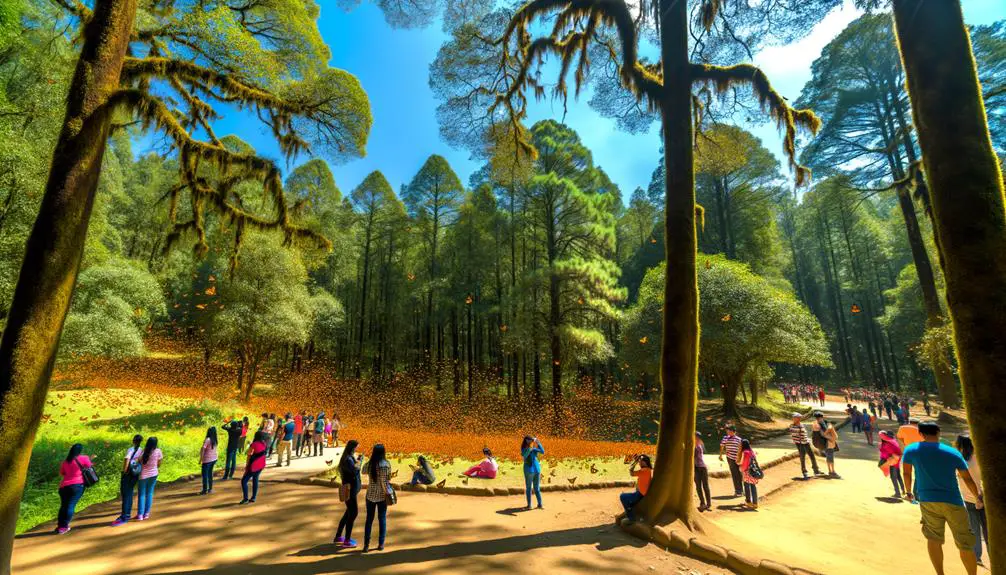
Visitor experiences at the El Rosario Monarch Butterfly Sanctuary are characterized by a profound sense of awe, as quantitative surveys indicate a high satisfaction rate among attendees who appreciate the biodiversity and ecological significance of the site. Data reveal several key aspects contributing to this sentiment:
- Biodiversity Observation: Attendees report a 95% satisfaction rate in witnessing diverse flora and fauna.
- Guided Tours: 87% of visitors find guided tours highly informative, enhancing their understanding of monarch migration.
- Photographic Opportunities: 92% of visitors highlight the exceptional photo opportunities, particularly during peak butterfly congregation periods.
- Educational Value: 89% of participants appreciate the educational materials and interactive exhibits available on-site.
These elements collectively underscore the sanctuary's role in promoting ecological awareness and appreciation.
Conclusion
El Rosario Monarch Butterfly Sanctuary serves as a critical haven for the monarch population, providing an essential role in their migratory journey.
The sanctuary's unique flora supports the butterflies' life cycle, while ongoing conservation efforts endeavor to mitigate human-induced threats.
Visitors gain not only aesthetic pleasure but also a deeper understanding of ecological balance.
This sanctuary stands as a beacon of biodiversity, its significance as crucial as the lifeblood coursing through an ecosystem's veins.


